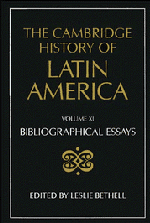Book contents
- Frontmatter
- I THE INDIGENOUS PEOPLES OF MIDDLE AND SOUTH AMERICA ON THE EVE OF THE CONQUEST
- II COLONIAL SPANISH AMERICA
- 1 The Spanish conquest and settlement of America
- 2 Indian societies and the Spanish conquest
- 3 Spain and America in the sixteenth and seventeenth centuries
- 4 Spain and America: The Atlantic trade, 1492–c.1720
- 5 Spain and America in the eighteenth century
- 6 Population
- 7 Urban development
- 8 Mining
- 9 The formation and economic structure of the hacienda in New Spain
- 10 The rural economy and society of Spanish South America
- 11 Aspects of the internal economy: Labour, taxation, distribution and exchange
- 12 Social organization and social change
- 13 Indian societies under Spanish rule
- 14 Africans in Spanish American colonial society
- 15 Women in Spanish American colonial society
- 16 The Catholic church
- 17 Literature and intellectual life
- 18 Architecture and art
- 19 Music
- III COLONIAL BRAZIL
- IV THE INDEPENDENCE OF LATIN AMERICA
- V LATIN AMERICA: ECONOMY, SOCIETY, POLITICS, c. 1820 TO c. 1870
- VI LATIN AMERICA: ECONOMY, SOCIETY, POLITICS, c. 1870 to 1930
- VII LATIN AMERICA: ECONOMY, SOCIETY, POLITICS, 1930 to c. 1990
- VIII IDEAS IN LATIN AMERICA SINCE INDEPENDENCE
- IX LATIN AMERICAN CULTURE SINCE INDEPENDENCE
- X THE INTERNATIONAL RELATIONS OF LATIN AMERICA SINCE INDEPENDENCE
- THE CAMBRIDGE HISTORY OF LATIN AMERICA
3 - Spain and America in the sixteenth and seventeenth centuries
from II - COLONIAL SPANISH AMERICA
Published online by Cambridge University Press: 28 March 2008
- Frontmatter
- I THE INDIGENOUS PEOPLES OF MIDDLE AND SOUTH AMERICA ON THE EVE OF THE CONQUEST
- II COLONIAL SPANISH AMERICA
- 1 The Spanish conquest and settlement of America
- 2 Indian societies and the Spanish conquest
- 3 Spain and America in the sixteenth and seventeenth centuries
- 4 Spain and America: The Atlantic trade, 1492–c.1720
- 5 Spain and America in the eighteenth century
- 6 Population
- 7 Urban development
- 8 Mining
- 9 The formation and economic structure of the hacienda in New Spain
- 10 The rural economy and society of Spanish South America
- 11 Aspects of the internal economy: Labour, taxation, distribution and exchange
- 12 Social organization and social change
- 13 Indian societies under Spanish rule
- 14 Africans in Spanish American colonial society
- 15 Women in Spanish American colonial society
- 16 The Catholic church
- 17 Literature and intellectual life
- 18 Architecture and art
- 19 Music
- III COLONIAL BRAZIL
- IV THE INDEPENDENCE OF LATIN AMERICA
- V LATIN AMERICA: ECONOMY, SOCIETY, POLITICS, c. 1820 TO c. 1870
- VI LATIN AMERICA: ECONOMY, SOCIETY, POLITICS, c. 1870 to 1930
- VII LATIN AMERICA: ECONOMY, SOCIETY, POLITICS, 1930 to c. 1990
- VIII IDEAS IN LATIN AMERICA SINCE INDEPENDENCE
- IX LATIN AMERICAN CULTURE SINCE INDEPENDENCE
- X THE INTERNATIONAL RELATIONS OF LATIN AMERICA SINCE INDEPENDENCE
- THE CAMBRIDGE HISTORY OF LATIN AMERICA
Summary
In addition to the general studies by Domínguez Ortiz, Elliott and Lynch, listed in essay II: I, there are a number of more specialized studies of Spanish government and society which ought to be taken into account by anyone interested in following the relationship between Spain and its American possessions in the sixteenth and seventeenth centuries. The best brief account of the reign of Charles V is by H. G. Koenigsberger, ‘The empire of Charles V in Europe’, in vol. 2 of The New Cambridge Modern History (Cambridge, Eng., 1958). There are two biographies of Philip II: Peter Pierson, Philip II of Spain (London, 1975) and Geoffrey Parker, Philip II (Boston and Toronto, 1978). But incomparably the most important study of the age of Philip II is by Fernand Braudel, La Méditerranée et le monde méditerranéen à l’époquede Philippe II, 2 vols., 2nd ed. (Paris, 1966); translated as The Mediterranean and the Mediterranean World in the Age of Philip II, 2 vols. (London, 1972–3), which is especially useful for tracing the shift in the centre of gravity of Spanish power from the Mediterranean to the Atlantic during the course of Philip’s reign. I. A. A. Thompson, War and Government in Habsburg Spain, 1560–1620 (London, 1976), is a pioneering piece of research into Spain’s organization for war and the strains imposed by warfare on the Spanish administrative system. For a study of the general who personified the ‘black legend’ for most of Protestant Europe, see William S. Maltby, Alba: A Biography of Fernando Alvarez de Toledo, Third Duke of Alba, 1507–1582 (Berkeley, 1983).
- Type
- Chapter
- Information
- The Cambridge History of Latin America , pp. 42 - 50Publisher: Cambridge University PressPrint publication year: 1995



